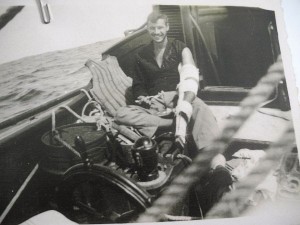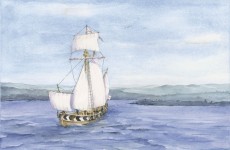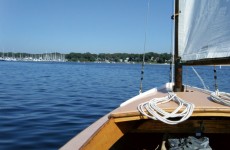I am old enough to vividly recall the summer day in 1945 on which WWII ended: My town, and the surrounding villages, erupted with honking car horns and joyful church bells. And I sensed, then, in a child’s way, the jubilation with which peace was received in America, and the exuberance with which soldiers, sailors, airmen, Merchant Mariners, and Coast Guardsmen returned to their homes.
 Some went to college under the Servicemen’s Readjustment Act of 1944 – the GI Bill – and started businesses, married their sweethearts, had children, and bought homes. Others went off the clock, spread their wings, and shed the memories of war. Stanley Cressey and Joe Petterson were two such veterans, and 70 years after that war’s end, we thought we’d tell you about a book published in 2013, “The Voyages of the Seven Seas,” that relates their post-war transatlantic adventures.
Some went to college under the Servicemen’s Readjustment Act of 1944 – the GI Bill – and started businesses, married their sweethearts, had children, and bought homes. Others went off the clock, spread their wings, and shed the memories of war. Stanley Cressey and Joe Petterson were two such veterans, and 70 years after that war’s end, we thought we’d tell you about a book published in 2013, “The Voyages of the Seven Seas,” that relates their post-war transatlantic adventures.
Stanley was valedictorian of his class at Morse High in Bath, Maine, and had graduated from Bowdoin in three years to be able to serve as an officer in the U.S. Army Air Force. Joe, a University of Maine engineering graduate, hailed from Bangor, where his father was a railroad engineer. Joe spent his summers sailing out of Northeast Harbor; Stanley, a wartime Merchant Mariner, had sailed nothing larger than a small catboat. When the two were mustered out, Joe had a plan: Buy a small boat and sail to Europe.
In April 1947, after scouring the Maine coast for a boat they could afford, capable of an ocean crossing, they found, in Blue Hill, the 38-foot gaff-rigged yawl Seven Seas, built in 1912. “With a few new planks, re-caulking, and three coats of paint, Joe figured we’d have something sound beneath us,” Stanley writes. “As I stood there while Joe jabbed his knife into seams and planks, I tried to form a mental picture of what she’d look like minus the broken planks and rust streaks. I didn’t have much luck.”
After a shakedown cruise to New York City, on Aug. 4, Stan and Joe headed for Bermuda, making landfall on Aug. 15, and departing for Europe Aug. 26: “Slowly the Atlantic swallowed up the island . . . . and now there is only the ocean and the sky both lighted by a brilliant moon. So bright that I do not need my flashlight to write,” writes Stan.
On Sept. 15, within 300 miles of the Azores, a storm overtook Seven Seas, and Stanley broke his arm when a wind shift caused a violent jibe. “. . . Joe cut one of our oars to size and padded one end to fit under my arm. . . . We were ready to pull the arm straight. . . . It wasn’t a bad job for amateurs . . . . the entry in the logbook reads: ‘Slight delay for one broken arm!'”
After 10 days as tourists in the Azores, Stan and Joe set sail for Portugal, arriving there Sept. 8, surviving serious visa difficulties, but greeted by a newspaper headline: “The Adventurous Voyage of the Seven Seas or the Story of the Two Americans Who Came to Help Celebrate the Centennial Festival of Lisbon,” which quickly ended all problems with anything in Portugal.
The men left Seven Seas in Portugal and took a train to Paris, where Joe studied painting and Stan taught at the American School. In March, Stan decided to stay in Europe (“A second attempt seemed to me both foolhardy and dangerous. It was tempting fate a bit too much.”), while Joe chose to sail Seven Seas home solo.
After a refit, on May 16, Joe and Seven Seas departed Portugal, bound for the Azores and America. “Man, is that sail rotten,” he wrote off Cape Sable. “Half the seams are ready to go. I’m glad I haven’t got far to go.” On July 10, he arrived in Northeast Harbor: “So ends, the long trick is over,” was his log entry. His Atlantic crossing set three transatlantic records: youngest to solo east to west, fastest passage, and oldest boat.
Compiled and edited by Robertson Brown and Jay Doggett, from the logs of Cressey and Petterson, this volume also has a special mission: All profits from royalties will go to the scholarship fund at Maine Maritime Academy in Castine. This marvelous book is available on Amazon for $9.75. FMI: www.amazon.com/Voyages-Seven-Seas-Robertson-Browne.



 We have complete issues archived to 2009. You can read them for free by following this link.
We have complete issues archived to 2009. You can read them for free by following this link.